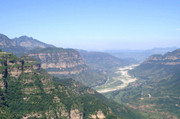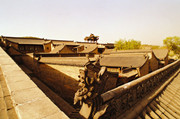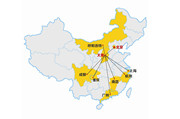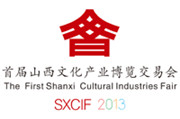Shanhua Temple murals presented in Beijing
By Gan Tian ( China Daily )
Updated: 2012-06-08
|
 Part of The Picture of Sakra and Brahmo, on display at CAFA Art Museum. Gan Tian / China Daily |
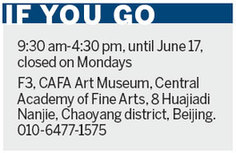 |
This is not a scene from a construction site, but a museum. These young artists are working on mural paintings, which are presented in the exhibition Renaissance: Restoration of the Murals of Shanhua Temple, Datong China, at the museum of the Central Academy of Fine Arts (CAFA).
The exhibition is unique as it not only displays traditional Chinese mural paintings, but also illustrates the process of how these works are created.
Some 10 young artists are seen sketching, dyeing and decorating on the shelf. Visitors get to witness how they mix the pigments, sketch outlines and dye the huge paintings.
Initiated by Sun Jingbo and Wang Yingsheng of CAFA's Studio One of Mural Painting Department in 2009, the project attracted lots of interest. More than 150 students from different departments wanted to be involved in it, including those who major in mural painting, wash-and-ink painting, block printing and even sociology.
Sun, a professor of CAFA Mural Painting Department and director of Studio One, says the project acts as an on-the-job training course for students.
Supporting the initiative, CAFA's president Pan Gongkai decided to open up a space within the academy's museum, where students can work freely without space constraints and visitors get to see them at work.
It is indeed a wise decision, as the project is huge. The main mural alone, The Picture of Sakra and Brahmo, a famous religious painting, measures 39.8 meters wide and 5.08 meters tall. Three other giant murals are also on display: The Five Buddhas, Manjusri Asks about the Illness, and The Picture of Vimaiakirti. Together, they occupy an area of 3,000 square meters.
These religious murals, coupled with sounds of bells and drums in the background, give the exhibition hall on the third floor of the museum, a temple-like atmosphere.
The teachers and students draw their inspiration from traditional Chinese murals. The completed masterpieces will be sent to Shanhua Temple in Datong and installed in its main hall.
"We can call it 're-creation', because the original works are missing. Our paintings are based on the very few left-behind records. The rest is based largely on our imagination and creation," Sun says.
"We are people of the 21st century who are trying to restore traditional Chinese mural painting skills of 16th century," he says.
Dong Zhuo, a 28-year-old mural painting major, took part in the project from day one. He says the most difficult part is to paint the faces of the characters, which is called kailian (means "open face" literally) in mural paintings.
Visitors may find it strange that the mural has characters without faces. That's because kailian is considered the most important part in this art as it shows the different facial expressions of the characters, and thus, it is done at the very end.
According to Dong and his classmates, painting facial expressions requires patience. Sometimes they sketch more than 100 faces to paint a perfect one. To truly capture the expressions, they have to view the finished work from every angle.
"We may feel satisfied with our painting when we are looking at it close-up. But when we look at it from another angle, sometimes we find the eyes too big or the nose in a wrong position," Dong says.
Despite the hard work, Dong doesn't regret majoring in traditional Chinese art.
"There are so many hidden secrets in the traditional murals," he says.
The exhibition will end on June 17.
gantian@chinadaily.com.cn
